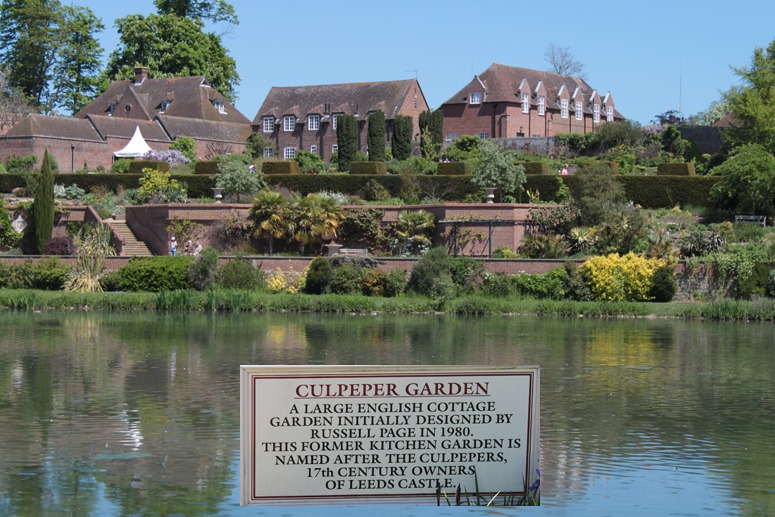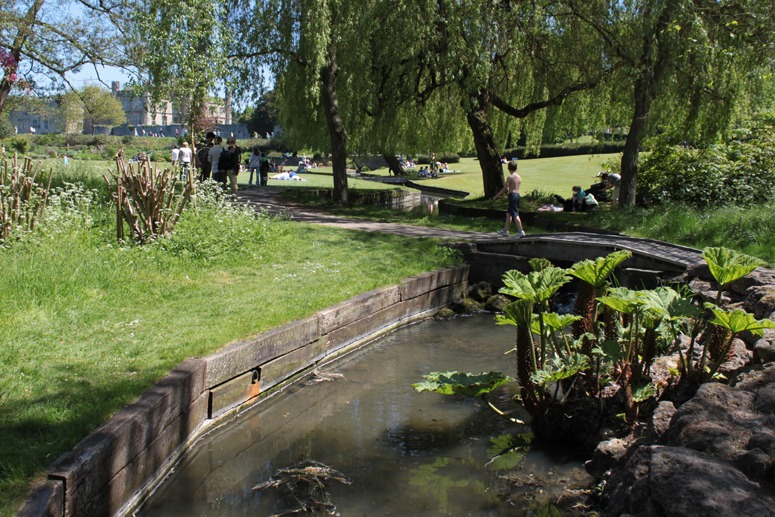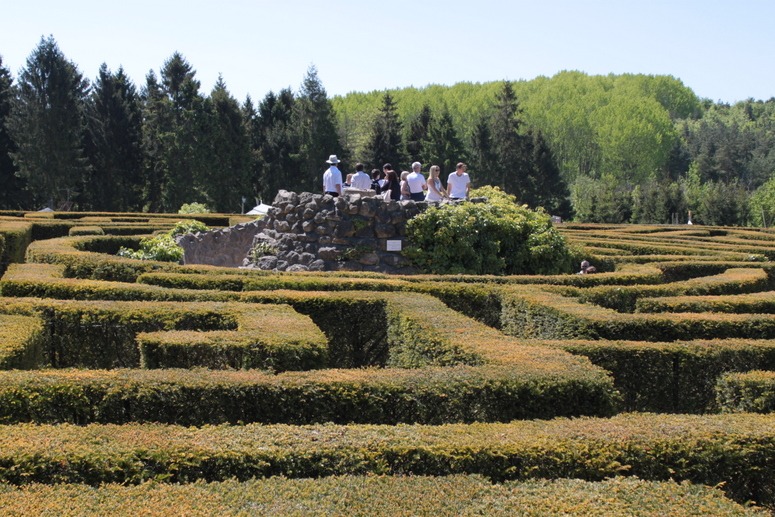 No. It does not.
No. It does not.
Leeds Castle gets enormous and well-deserved publicity as ‘the lovliest castle in England’ and is crowded with visitors paying £17.50 each in 2010. My guide book says the garden is Grade II listed. If correct, this is ridiculous. The designed landscape around the castle should be Grade I+++ listed. The riverside garden and the Culpepper Garden (supposedly designed by Russell Page) are mediocre. But why? With such a host of visitors the Leeds Castle Foundation must have a sufficiency of funds. I would not criticise the design if it were a public park in run-down town in a depressed part of the English Midlands. But for the surroundings of the very finest example of a designed medieval landscape in England – I recommend the appointment of a skilled designer-manager. England has few better places in which to dream of gallant kings, beautiful maidens and the age of chivalry. At the time of their marriage, in 1524, Edward was 15. Eleanor was 10 years old, Spanish and beautiful. It was an exceedingly happy marriage, arranged by their parents. They had 16 children. Edward was a great military leader and in 1271 he and Eleanor were in Acre, crusading. Her child miscarried and they returned home via Rome, where they met the Pope, and via Paris. We would frown on the early marriage and the anti-Muslim crusade. One can rarely judge an earlier age by the standards of a later age – but we need have no reservations in criticising the current design of Leeds Castle Gardens. It’s pathetic. And why did they litter the streambank with old railway sleepers?
England has few better places in which to dream of gallant kings, beautiful maidens and the age of chivalry. At the time of their marriage, in 1524, Edward was 15. Eleanor was 10 years old, Spanish and beautiful. It was an exceedingly happy marriage, arranged by their parents. They had 16 children. Edward was a great military leader and in 1271 he and Eleanor were in Acre, crusading. Her child miscarried and they returned home via Rome, where they met the Pope, and via Paris. We would frown on the early marriage and the anti-Muslim crusade. One can rarely judge an earlier age by the standards of a later age – but we need have no reservations in criticising the current design of Leeds Castle Gardens. It’s pathetic. And why did they litter the streambank with old railway sleepers?
The maze at Leeds Castle is of a different quality: it is well conceived, well made, well positioned and popular. Unicursal (one-path) labyrinths were popular religious symbols in the middle ages and symbolized the spiritual path a pilgrim might take. Multicursal (many-path) mazes were popular renaissance games. They were fun to experience and symbolic of the difficulties of finding and winning the game of love: a fair maid might be placed at the centre of a maze. The Leeds Castle Maze is enjoyed in precisely this way and does not conflict with the medieval castle landscape.


Of their sixteen children it is said only six survived into adulthood…to enjoy the gardens at Leeds castle. [ http://www.biographybase.com/biography/Eleanor_of_Castile.html ]
Though I suppose they never got the opportunity to ride a segway either.
[ http://ezinearticles.com/?Leeds-Castle,-Kent—One-of-the-Most-Favourite-Castles-of-Henry-VIII&id=4217018 ]
The dedication of medieval families to procreation is amazing. One could think it was because they had no means of birth control but I do not think this was the overwhelming reason. They had a devotion to God, Duty, King and Country which required the generation of children. And if we desire a sustainable steady-state population then we need revised belief systems to guide our actions. And yes, wanting more money to spend on Segways and other consumer products could be part of it!
Difficult to say. Somehow the fairytale romance aspect of their relationship still has appeal. That is perhaps the best reason I can think of to have a love child or two or sixteen.
Fortuneately perhaps modern medicine makes reproduction more efficient! In developed countries at least most children survive into adulthood. And more parents survive bearing and rearing children!
[ http://www.washingtonpost.com/wp-dyn/content/article/2007/01/14/AR2007011400480.html ]
With sixteen children you would need a big garden. Could easily skip the Segway.
I have added a photo and a comment on the maze at Leeds Castle. A maze was a popular medieval symbol for the dilemmas of courtship, sex, love and childbirth. They have changed. But they remain as amazing as ever they were. Modern medicine facilitates childbirth and seems to discourage couples from breeding – and both funded as part of a public health service in many countries. It produces the weird situation where some hospital wards are aborting foetuses while others are trying to improve fertility. Maybe these dilemmas will be taken up by post-post-post-postmodern garden designers. At present there is not nearly enough romance, love, sex and marriage in garden design. For Christ’s sake, have we stopped dreaming?
Perhaps one place for a designer to find inspiration for a contemporary garden might be William Blake’s poem ‘The Garden of Love’. [ http://en.wikipedia.org/wiki/The_Garden_of_Love ]
Hard to say whether Josephine was fortuneate or unfortuneate in having Alexandre, the husband of her arranged marriage, sent to the gullotine therefore saving her from a match she did not want? One would hope there were better ways of avoiding an unhappy marriage!
[ http://www.princessmichael.com/articles/19_1.html ]
Strange to think of the French capturing British ships as late in history as the 1700s…
Should we feel sorry for the Archduchess Marie Louise whom Napoleon regarded as a dynastic womb?
Alternatively the Japanese Tanabata festival could also inspire a garden…
[ http://www.kuanhoong.com/2007/07/07/tanabata-festival-7th-july-make-a-wish/ ]
Thank you for the link to William Blake’s “The Garden of Love”, reproduced below because I like it – and I think the Empress Josephine would have liked it too:
I went to the Garden of Love,
And saw what I never had seen;
A Chapel was built in the midst,
Where I used to play on the green.
And the gates of this Chapel were shut,
And ‘Thou shalt not’ writ over the door;
So I turned to the Garden of Love
That so many sweet flowers bore.
And I saw it was filled with graves,
And tombstones where flowers should be;
And priests in black gowns were walking their rounds,
And binding with briars my joys and desires.
Marie Walewska and Marie-Louise seem to have had a hard time of it – though I remember reading of an earlier French king who had 250+ children
Fortuneately 250 + children is not the global average.
At present the global average family size is 2.6 children. Which on the face of it doesn’t sound like a problem. However,the global population is double and a halfing each generation.(Although I am not sure how many years there are in an average generation?)
Populations are doubling in the developing world and halving in the developed world. I wonder what the consequences of this will be?
Growth “has been in developing countries where advances in public health have contributed to lower mortality at all ages. Until recently, death rates fell faster than birthrates, resulting in rapid population growth.”
With falling mortality rates the population picture is even more extreme…
It is strange to think that good news, health advances, might also be bad news in terms of population pressure with its ongoing consequences for the environment. (For example pressure on land, forests, fauna, resources and ‘under common but differentiated responsibilities’ less sustainable development practices).
There are some intersting maps and tables and bar charts showing world population growth. It seems the great divide is not so much between developed and developing countries as between the Mother Continent and The Rest – with Arabia joining with Africa, and some other surprising exceptions. A curious aspect of Africa is that despite the poverty and other problems it is a continent with the resources to support the population growth – if it was managed like China, for example. And since China is taking over the the management of Africa this could happen. Let’s hope the African elephant does not follow the tracks of the Chinese elephant.
Thankyou, they are very interesting maps, tables and bar charts. To get a true picture of population and its effect on environment would seem to require a significant amount of research and interpretation.
Yes, I agree resources do support population growth, however political stability is also important. This is most likely where most of Africa’s challenges arise – as the boundaries of African states are a colonial construction.
Colonialism (eg the Romans and Normans)and immigration (eg the Jews and Hugenots) did the UK a lot of good – and I can’t see that Hong Kong has done China much harm either, despite the views of the CCP. Slavery, and especially the middle passage,was a bad and wicked thing. It was not, however, a European introduction to Africa and nor has European influence eliminated it from Africa. But, yes, the borders imposed by the European colonial powers were, so far as I can see, an unmitigated disaster. As to whether Africa would have been better off without any borders (ie as one country), or where they should have been drawn, I have no idea!
Absolutely. It is a big question. To put the subject in perspective, here is a map of Indigenous Australia.
[ http://www.aboriginaleducation.sa.edu.au/files/pages/aboriginal_aust/ab_aust_full.pdf ]
It is very different than the map most people are used to seeing.
[ http://www.map-of-australia.co.uk/political-map-of-australia.htm ]
So I guess the problem becomes how do you reconcile the two maps?
The Aboriginal Map of Australia is fascinating and has a distinct resemblance to the results from an image search for habitat map. But I suppose the only thing this resemblance illustrates is the difference between hunter-gatherer societies and settler-agriculturalist societies. Luckily, this takes us back to Leeds Castle! The combination of a dwelling with a hunting park is a classic response to the nomad/settler ‘zone of interchange’ which characterizes gardens/landscapes all around the fringe of Central Asia. The suburban development pattern now so common in Australia and elsewhere follows the classic model by trying to accommodate both the instincts of the hunter and the habits of the settler. The progressive extinction of the hunter-gatherer lifestyle, and the habitat pattern it rested upon, makes me feel sad. Is the rabbit more virtuous than the fox? Is one lifestyle ‘better’ than another? Think what will happen to foxes when all the rabbits have gone – or to rabbits, feral cats and Australian agriculture, when all the dingoes have gone!
A little on fox hunting….(the photograph is a gem!). I suppose some reassessment of hunter/gathering societies might also assist us to understand a philosophy of culture?
[ http://www.greenacres-stud.com/foxhunting.htm ]
I like the photo! – and fox hunting is problematical: (1) one has to respect the ancient ‘art’ of the hunter (2) ‘killing for pleasure’ is not an activity one can support (3) but learning the skills of the hunter may be OK. But I certainly think the English have to allow ‘hunting for pleasure’ if they are going to allow ‘fishing for pleasure’ (ie coarse fishing). Legislating against the leisure activities of one social class must be wrong, even if it is the upper class.
I wonder where the distinction between recreation, sport, conservation and consumption lies? [Think whaling controversies.]
The difficult classifications are, well, difficult. But so long as people are not eating foxes I would definitely class fox-hunting as recreation. Ditto tigers.
Does the fox get to live another day? Is there a conservation imperative in reducing the number of foxes in the countryside?
It seems that tiger-hunting, following kingship traditions in India, became part of British-Indian male identity.
[ http://www.britannica.com/bps/additionalcontent/18/23966257/Face-Him-Like-a-Briton-Tiger-Hunting-Imperialism-and-British-Masculinity-in-Colonial-India-18001875 ]
Perhaps the Victoria and Albert would further the debate about hunting in its various forms by designing an exhibtion around ‘Tipu’s Tiger’?
Many people think the UK fox population is growing, particularly in urban areas but the stupid ban on hunting seems to have had little impact on this http://www.wildlifeonline.me.uk/questions_answers_foxes.html#increasing . The stupidity was that it infuriated many people and did nothing to stop them hunting foxes.
Hunting lions and tigers has been a proof of one’s suitability for kingship and mating since Paleolithic times. See http://www.upenn.edu/pennpress/book/14223.html
Now that sacred kingship is out of fashion I suppose we no longer need lions and tigers to hunt. But I would like to see a lot more deer parks in Europe. Richmond Park is a wonderful example in London and there are many others in the UK. In fact I would love to see the golfers at Leeds Castle joined by deer – the combination seems fine at Knole Park, also in Kent. http://www.knoleparkgolfclub.co.uk/index.lasso?pg=f5cb0789f3128f74&catid=0a74a336c940364c&mp=260fa8a7abc9c893 Deer could also be a sustainable protein source. Hunters could pay large sums to ‘shoot’ them with sticky mini-transmitters. If successful, the victims could be ‘humanely’ caught and sent to abattoirs. Now there’s a money-making idea for someone! People pay £150-£500/day for cruel deer stalking http://www.deerstalkingscotland.co.uk/stalkingcosts.html
Perhaps it is a good time to reconsider hunting etiquette?
In ‘People and Forest: policy and local reality in Southeast Asia, the Russian …the authors say (p301):
“Hunting…is one of the traditional and most prestigious activities of the Udeghe people. Though the overkilling of animals, which sometimes happens, is often condemned as a typical cause of the destruction of the natural environment, hunting itself is beginning to be recognised as one of the styles of sustainable non-timber forest use in the indigenous’ people’s territories. In fact, indigenous hunters have demonstrated the sustainability of hunting for hundreds of years under various political and social conditions.”
Whoops – the full title of the book is …the Russian Far East and Japan’.
Yes – it is time.
Could rabbit-eating be popular in Australia? It could be a good way of controlling a ‘pest’ and having a sustainable supply of protein.
Well yes. But the rabbits for consumption tend to be specially breed from domestic stock rather than the industry existing as a way of controlling a ‘pest’.
[ http://www.dpi.nsw.gov.au/__data/assets/pdf_file/0003/75882/Farming-meat-rabbits-in-NSW—Primefact-104-final.pdf ]
Wild rabbits however were consumed in Australia during the Great Depression.
[ http://www.cultureandrecreation.gov.au/articles/foodanddrink/ ]